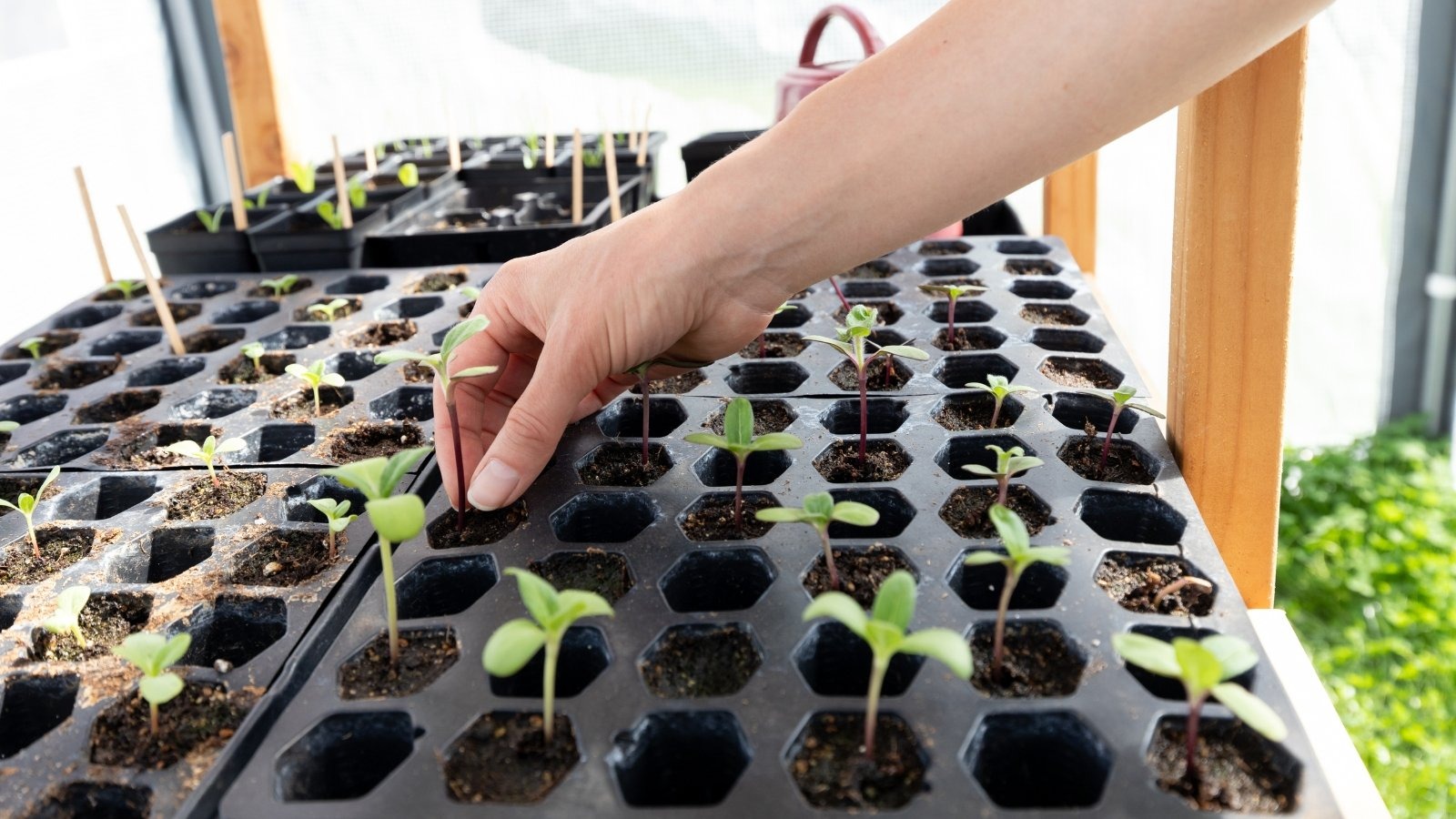Germination Don’t’s: 5 Seed Starting Mistakes That Can Sabotage Your Garden
Starting seeds seems simple at first. Add some soil, tuck in a few seeds, water them, and wait. But if you’ve ever been disappointed by empty trays or weak, wilted seedlings, these happen more often than you know. Germination is one of the most important stages in your garden’s life cycle, and it’s also where many things can quietly go wrong.
If your seeds aren’t sprouting or your seedlings keep dying early, chances are one of these five common mistakes is to blame.
1. Using the Wrong Containers
Not all containers are created equal. A yogurt cup or leftover plastic pot might seem like a good idea, but if it doesn’t drain properly or gives roots too little room to grow, it can quickly cause problems.
When seeds don’t have enough space, roots get tangled, water pools at the bottom, and airflow gets blocked. This creates a perfect storm for rot, mold, and weak roots.
Instead, use seed planting trays explicitly designed for germination. These trays typically have individual cells that separate seedlings and help prevent overcrowding. They also include drainage holes, so excess water doesn’t sit at the bottom and harm your plants.
2. Overwatering or Underwatering
Watering seems simple, but it’s one of the biggest causes of seed failure. Too much water, and your seeds might rot before they even sprout. Too little, and they won’t have the moisture they need to activate and grow.
Signs of overwatering include soggy soil, fungus, or green algae on the surface. Underwatering leads to dry, cracked soil or seedlings that stop growing.
The solution is keep the soil consistently damp, not soaked. A gentle spray bottle works well in the early days. Better yet, consider using planting trays with bottom-watering systems so your plants can absorb just what they need without sitting in standing water.
3. Poor Soil Choice
Grabbing a scoop of dirt from your backyard or using leftover potting mix is tempting, but seed-starting requires something more precise. Heavy or dense soil can smother delicate roots and slow germination.
A proper seed-starting mix is light, airy, and sterile. This gives seeds the right blend of moisture retention and drainage, reducing the risk of fungus or pests hiding in unsterilized soil.
Good soil is the foundation of healthy growth. Without it, even the best seeds in the best trays will struggle to push through.
4. Ignoring Temperature and Light Needs
Some gardeners start seeds on a windowsill and hope for the best. However, many seeds have very specific needs when it comes to warmth and light. Cool air and short days can cause slow germination or thin, leggy seedlings that never recover.
Most seeds germinate best in temperatures between 65°F and 75°F. If your space is cooler, try using a seedling heat mat. These small mats sit under your trays and gently warm the soil.
Natural sunlight isn’t always enough for light, especially in early spring. A small LED grow light placed just a few inches above your seedlings can make all the difference. Keep it on for 12–16 hours a day to encourage strong, compact growth.
5. Planting Too Many Seeds Together
It might feel like you're increasing your chances of success by planting multiple seeds in one spot, but overcrowding can cause more harm than good. When too many seedlings grow together, they compete for space, air, and nutrients. Their roots tangle, and thinning them out later can damage the ones you want to keep.
Instead, stick to one or two seeds per cell or pot. If you're using good seed planting trays, this becomes much easier to manage. When the time comes, you’ll get healthier seedlings with stronger root systems that are easier to transplant.
Final Thoughts
A strong garden starts with a strong beginning. And the germination stage, though small and quiet, is one of the most important. If your seeds aren’t doing well, don’t get discouraged. These early mistakes are incredibly common and very fixable.
By using the right setup (like proper planting trays and grow lights), being mindful of water and temperature, and giving each seed the space and soil it needs, you’ll give your plants a much better shot at thriving.
Next time you start seeds, make a few small changes, and you’ll be amazed at the difference when those healthy green sprouts start pushing through the surface.




This comprehensive guide on the five common mistakes Beginners make while starting seeds, 'Germination Don'ts,' has been a game-changer for amateur gardeners like me. It provides valuable tips to avoid setbacks and nurture healthy growth.
Germination Don'ts: 5 Seed Starting Mistakes That Can Sabotage Your Garden provides a valuable guide for gardeners looking to avoid common errors, ensuring their seedlings thrive and yield productive results.
Germination Don'ts: 5 Seed Starting Mistakes That Can Sabotage Your Garden provides a valuable lesson for gardeners wanting to avoid the pitfalls of seed starting. Its practical advice and王的rrint-down list will empower even novice growers, ensuring lushness beyond expectations.
Seed starting without realizing the mistakes outlined in 'Germination Don'ts: 5 Seed Starting Mistakes That Can Sabotage Your Garden,' is like planting hopes instead of seeds - sure to sprout disappointment. A must-read for aspiring gardeners aiming towards a lush and bountiful harvest.
If you're hoping for a thriving garden this season, avoid the pitfalls of seed-starting as outlined in Germination Don’ts: 5 Seed Starting Mistakes That Can Sabotage Your Garden. This guide is your starting point to sprouting success!
As a seasoned gardener, 'Germination Don’ts' is an invaluable guide that illuminates the perilous potholes of seed starting missteps. It acts as a lifesaver by highlighting five common mistakes made at crucial stages to ensure your garden thrives instead.
尝试在阳台或家中开始一项盆栽项目时,'Germination Don&rsquos: 5 Seed Starting Mistakes That Can Sabotage Your Garden'(萌芽的“不原则:让你的花园失败的五个种子种植错误)是一本清晰指明这些常见陷阱的有用指南,它不仅教导你如何正确播种以获取最佳成长可能性来拯救摇摆中的幼苗梦想们!"
Don'ts for new gardeners: Germination Don’t s provides crucial insights into the lethal mistakes that can stunt the growth of a thriving seedling collection. Its humorous yet informative tone makes it an essential guide to avoid, ensuring vibrant green spaces outdoors.














